






HMS Venomous at Falmouth
Conversion to an Air Target Ship and the start of her final Commission
October 1943 - August 1944
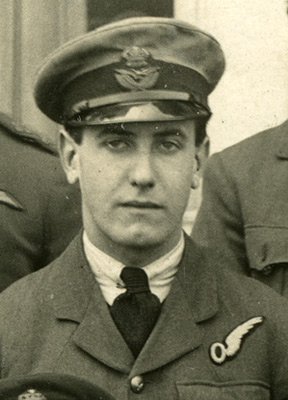
 My father was 43 and the father of three sons when he was called up for service in the Royal Navy and sent to HMS Forte, the shore base at Falmouth, before joining HMS Venomous. I was six years old when
he returned home in 1946. I asked the question all children asked
their fathers, "what did you do in the war"? He told me about HMS Venomous and said he was on an Arctic Convoy to Archangel in North Russia. The names of HMS Venomous and Archangel stuck in my memory.
My father was 43 and the father of three sons when he was called up for service in the Royal Navy and sent to HMS Forte, the shore base at Falmouth, before joining HMS Venomous. I was six years old when
he returned home in 1946. I asked the question all children asked
their fathers, "what did you do in the war"? He told me about HMS Venomous and said he was on an Arctic Convoy to Archangel in North Russia. The names of HMS Venomous and Archangel stuck in my memory.
After
my retirement from the
University of Hertfordshire Press in 2003 I began researching the life
of my father who spent "forty years at sea" as a marine engineer and
served in both World Wars. He was born in 1900 at Gateshead on the
opposite bank of the Tyne from Newcastle and on his eighteenth
birthday, 3 April 1918, three day after the establishment of the
Royal Air Force, he enlisted in the RAF and after commissioning as
Sub Lt W.R. Forster RAF served as an Observer Gunner in Short 184
Seaplanes
at Houton Bay Air Station on Scapa Flow, Orkney, on
anti-submarine patrol. After the war he completed a trade
apprenticeship as a fitter at a shipyard on the Tyne and joined Eagle
Oil as a junior engineer on oil tankers and by 1933 was a Chief
Engineer on tramps. In 1938 after 18 months as the shipbuilder's
Guarantee Chief Engineer for RFA Aldersdale
he left the sea and worked for the Aeronautical Inspection Directorate
of the Air MInistry inspecting the work of the Rolls Royce inspectors of Merlin Engines at a
greenfield "shadow factory" near Crewe. In October 1943 the Royal Navy
decided they needed him more than the Air Ministry and Lt(E) William
Redvers Forster RNR was posted to the Engineering Office of HMS Forte at Falmouth and joined HMS Venomous during her refit.
Falmouth and HMS Venomous played an important part in my father's life and inspired me to publish a new edition of a small pocket book about HMS Venomous written and self published by Bob Moore, the CO of TS Venomous, the Sea Cadet Unit at Loughborough. After the death of Bob Moore in 2007 Capt John Rodgaard USN (Ret) took over as lead author. I published a 389 page paperback in 2010 and a 480 pages larger format hardback edition with five new chapters and 258 photographs in 2017. This led to me setting up a website for the V & W Destroyer Association to tell the story of all these elderly destroyers built at the end of World War 1 which were brought out of "retirement" in the Reserve Fleet to escort Atlantic and Arctic Convoys.
I had no plans for a fourth edition of A Hard Fought Ship (2017) and decided to resume work on the uncompleted account of my father's life, Forty Years at Sea: a voyage with my father. My wife is from Hamburg, the daughter of a doctor who served in the German Kriegsmarine during the war. After we met on an EU funded exchange programme between universities we had a wonderful
holiday together in Cornwall at Carwinion on the Helford river but had
never visited Falmouth. In September 2019 we decided to rent an apartment off Castle
Drive, the road leading to Pendennis Castle at the entrance to Carrick
Roads and Falmouth harbour. The bad weather provided an excuse for researching my father's time at HMS Forte while HMS Venomous was bing refitted as an air target ship by Silley Cox & Sons, the naval dockyard.
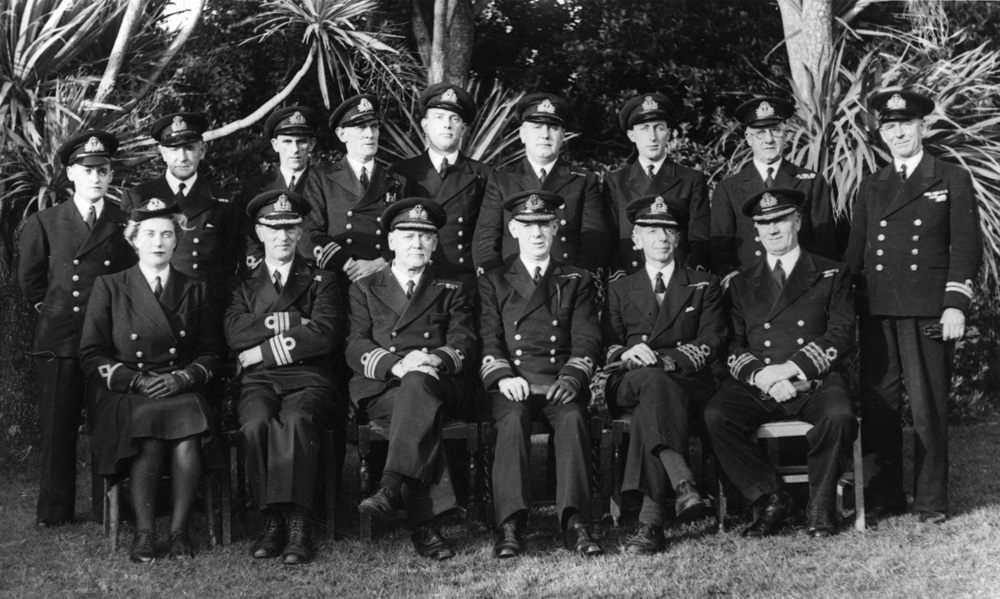
Eng Capt Sydney G. Roch RN was Base Maintenance Engineer at HMS Forte, Lt Cdr W.C.G. Keats RN his deputy and Lt(E) William R. Forster RNR and Lt(E) H.D. Seed RNVR were on his staff
The names of those present were
recorded on the reverse but the occasion is not noted or the location
but is assumed to be in Falmouth, probably HMS Forte 1
See the entries from the Navy List for the second quarter of 1944 below
Copyright reserved
 |
 |
HMS Forte was selected as the name for the Falmouth Naval Base when it was commissioned on the 24th August 1939. The name was traditional, having been used for various ships and shore establishments since 1799. It was initially based in the Tregwynt, now the Membly Hall Hotel but subsequently expanded to three other locations. The Treqwynt, Naval HQ, became Forte I and acquired an underground plotting room manned by WRNS which was to become a centre for planning the St Nazaire raid. Forte II was based in the Imperial Hotel just outside the entrance to the docks which provided further admin support, a sick bay etc. The location of Forte III was in Taylor's Garage overlooking the inner harbour which is now the Trago Mill discount store. There was a lookout on the roof and its special function was contraband control. Forte IV was based at wharves on the Penryn River between Falmouth and that town and was a coastal forces base. It also was involved in the St Nazaire raid. HMS Forte was finally paid-off on the 31st January 1946. Most of this information comes from Shore Establishments of the Royal Navy (Maritime Books, 2000) by Ben Warlow.
It is a reasonable assumption that Capt Roch was the organiser of the meeting as well as hosting it at HMS Forte
in Falmouth and that it was in some way related to his role as Base
Maintenance Engineer. It is tempting to assume it was to do with
preparing the Landing Ship Tanks (LST) for the Normandy Landings since
they were critical to the success of the landings and very few RN
marine engineers were familiar with them (they were built in the USA)
but other explanations have also been suggested.My best chance of finding out anything further about this meeting
would be if I were contacted by the families of the men (and one woman,
3rd Officer Dickerson) in the photograph. If you visit this page do please e-mail me.
It has not been
possible to identify with certainty all the officers listed on the
reverse of the photograph but they came from RN shore bases in the
south of Britain including HMS Drake, the Devonport Dockyard at Plymouth (Eng Capt H.H. Gordon RN), HMS Vernon at Portsmouth (Cdr A. Bryant RN), HMS President 111
the accounting base for men allocated for service on Defensively
Equipped Merchant Ships (DEMS) had moved from Bristol to London by
1944 (Cdr Theophile Le Blancq Pirouet RNR, Lt L. Angove, Lt Cdr E.J.
Luscombe and 3/O J Dickerson WRNS). A Teleg Lt E.N Dennis was at HMS Forte which only leaves Lt Hart and Mr Perkins to be identified. Confusingly, the number of stripes on the sleeves of some of the
retired officers recalled to service in 1939 do not correspond to their
ranks.
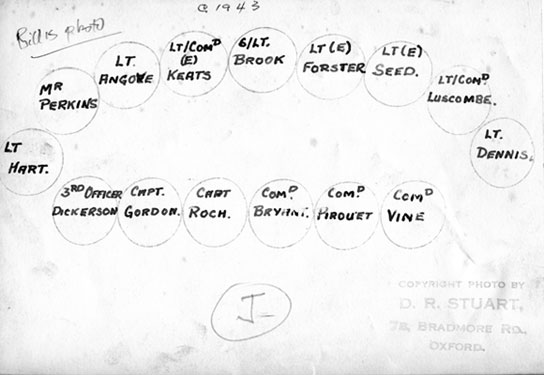 The names of the officers were written on the reverse of the photograph above
|
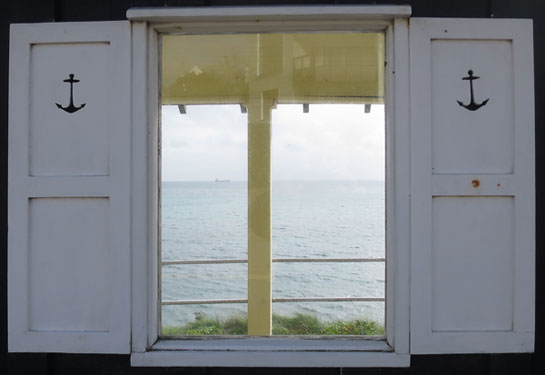 One of the elegant windows and shutters with cutout anchors in the bus shelter below
|
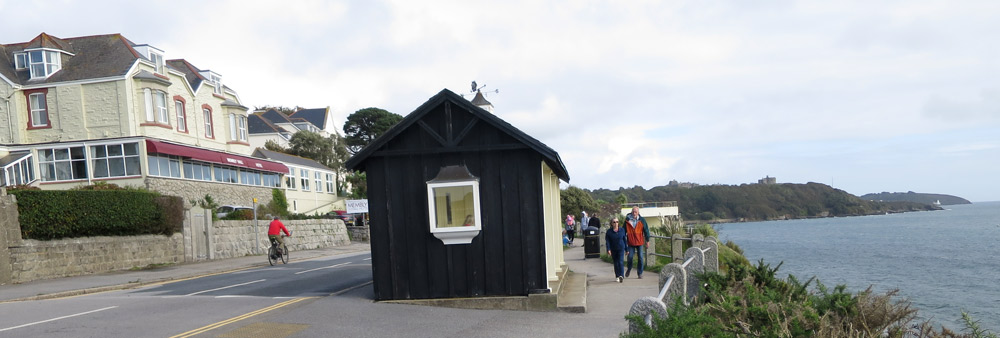
The bus shelter presented by
the CO of US Naval Forces in Falmouth to the Mayor in July 1945 still
stands outside the Membly Hall Hotel, formerly HMS Forte 1, near popular
"Gully" Beach
HMS Forte also had sites in the Imperial Hotel opposite the dockyard (Forte 2), Trago Mill discount store (Forte 3) and a coastal forces base on the Penryn river (Forte 4)
Pendennis Castle is visible on the headland beyond with the entrance to Carrick Roads and Falmouth harbour behind
Photographed by Bill Forster in September 2019
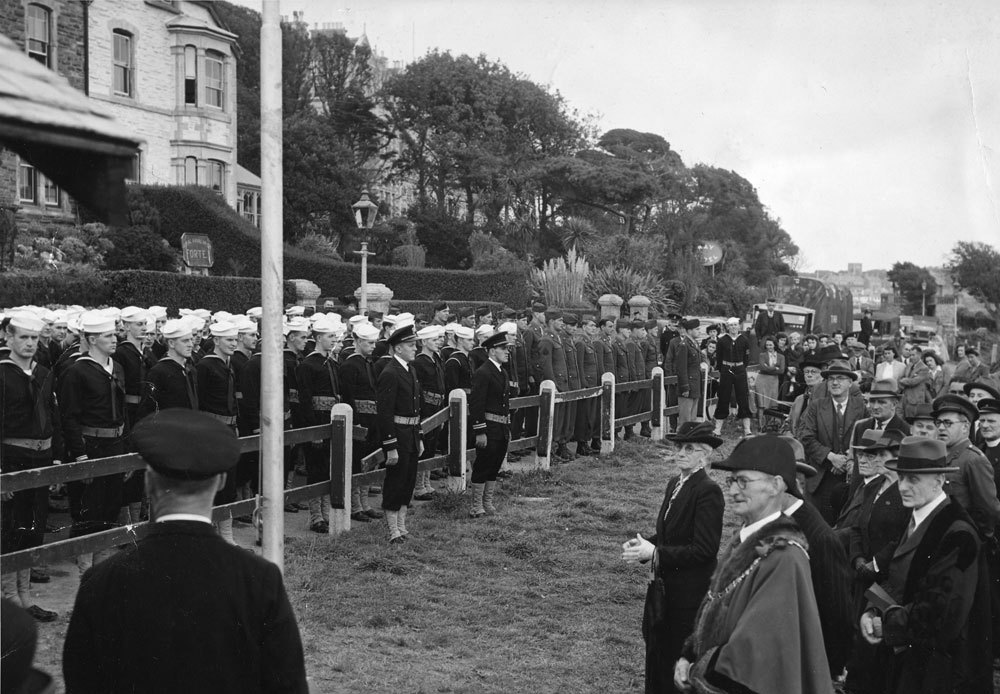
The presentation of the elegant bus shelter to Falmouth by the Commanding Officer of US Naval Forces in the town in 1946
Falmouth was a US Navy base in the buildup to D-Day and US Forces
landing on Omah and Utah Beaches in the American sector suffered the
heaviest casualties
From the collection of the Falmouth History Archive @ The Poly
The weather was
awful but this gave me an excuse to further my research and visit the
places in Falmouth linked to my father and HMS Venomous.
I was particularly keen to identify the name of the ship in which my
father went on an Arctic Convoy to Archangel in the White Sea of North
Russia. I knew it was not Venomous
and there was nothing in his service certificate but I recall him
telling me so clearly that I was in no doubt that he had been there.
The only clue was my elder brother's belief that during his time in
Falmouth he was on a tanker. It was fortunate that Lesley James, our landlady, was a close friend of Penny Phillips BEM,
Executive & Customer Support Assistant at A & P Falmouth Ltd, the
company which owns the dockyard of Silley Cox & Co where Venomouswas
refitted in 1944. Penny has the Logbooks of Silley Cox in which the
dates ships entered and left the four graving docks are recorded. She
is also
the Chairman of The Mission to Seafarers branch in Falmouth, and
Manager of The Flying Angel Centre. There is no public access to the
dockyard but we were
permitted to enter to study the logbook and visit the Flying Angel
Centre where Penny's partner, Graham Hall, has created a masterful
sculpture of a seaman on watch on an Arctic Convoy.
Tony Pawlyn, Hon. Head of Research at the Bartlett Library in the National Maritime Museum at
Falmouth, and his team of volunteers are very helpful. Their collection includes the Harbour
Masters
Journal recording the names of all merchant ships entering Falmouth
Harbour and Fox’s Arrivals Books,
the books of one of the two shipping agents in Falmouth, which contain
more
detailed entries. The tankers chartered by the Trade Division of the
Admiralty to refuel the escorts for Atlantic and Arctic Convoys are
included in the Harbour Master's Journal and Fox's Arrivals but not
Royal Navy warships. Finally, the dedicated
volunteers in the Falmouth History Archive at "The Poly", The Royal
Cornwall Polytechnic Society, assist researchers on Tuesday and
Thursday mornings. Email: history@thepoly.org
*******************
FALMOUTH DOCKYARD
Where Venomous was refitted as an Air Target Ship in 1944
There have been at
least two books published about Silley Cox & Sons, the firm that
owned Falmouth Docks until they were taken over by the present owner,
A&P Falmouth Limited, but neither contain much information about
the role of the docks during World War 2. In 1939 Falmouth Dockyard had
four dry docks (graving docks) where ships could be mounted on blocks
for major repairs or refits, and there were storage tanks on site for
20,000 tons of fuel oil. Most of the work Silley Cox did would have
been for the Admiralty or the Ministry of War Transport. The Admiralty
gave instructions to HMS Forte on the refit of HMS Venomous and other warships and these would have been conveyed to Silley Cox and the work supervised by HMS Forte.
The programme to
convert merchant ships into Merchant Aircraft Carriers (MAC) by the addition of
a flight deck to provide air cover for convoys beyond the range of
shore based aircraft began in mid 1943.
Nine of the merchant ships selected for conversion were oil
tankers belonging to Anglo Saxon Petroleum (owned by Shell) and two of these were
converted by Silley Cox at Falmouth. MV Avica entered service in October 1943 and MV Adula
in February 1944. They carried a normal commercial cargo of oil and
refuelled convoy escorts. The officers and crew were Merchant Navy but
the RNAS provided the flight crew for the three Swordfish aircraft. The
MAC conversions came into service after the Escort Carriers built
at shipyards on the East Coast of America were transferred to Britain
under lend lease, and before the Nairana class Escort Carriers (eg HMS
Vindex and HMS Campania) were built in the UK. Escort Carriers carried fighter planes as well as Swordfish and were
crewed by officers and men of the Royal Navy, and although based on
merchant ship hulls they did not a carry a commercial cargo. When Arctic Convoys resumed in
September 1942 after the terrible losses suffered by PQ17 the escort for PQ18 included the escort carrier HMS Avenger
which provided stiff opposition to attacks by German bombers based in
Norway. After the war ended Silley Cox was given the job of converting
the Avica and Adula back to tankers.
The Log of ships
entering the graving docks at Silly Cox are the best guide to the work
being done and from mid 1943 until July 1944 the docks were full of
Landing Ship Tanks (LST) mostly built in the USA.The exact nature of
the work required to prepare them for the D-Day landings in
Normandy is at present uncertain but their engines were of a type not
used by the Royal Navy and a particular cause for concern.
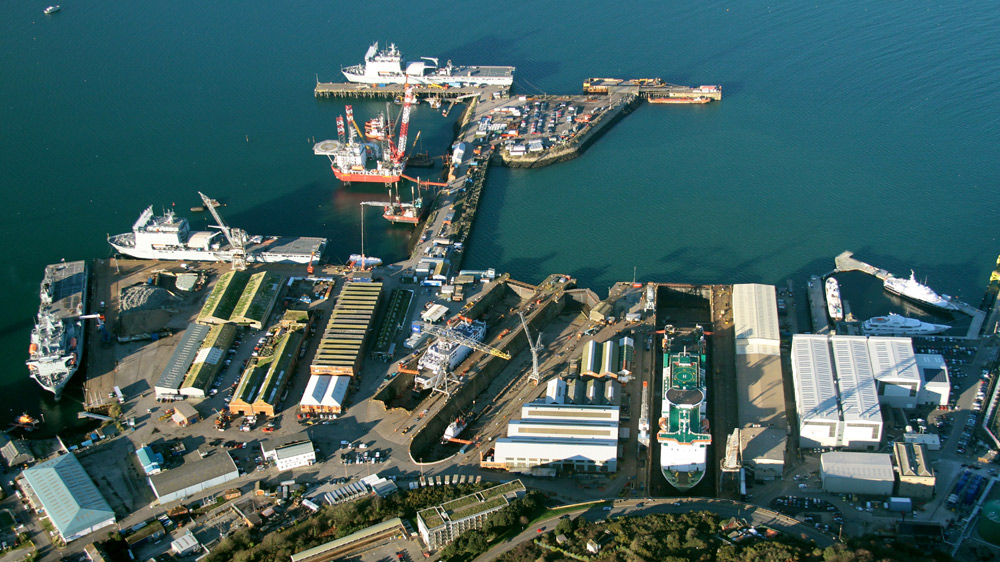
A postwar aerial view of the Docks at Falmouth showing Drydock Number 2 on right where HMS Venomous was converted to an Air Target Ship in 1944
A similar view can been from a layby with safety rail on the harbour side of the road round Pendennis Castle.
This dry dock was enlarged and renamed the Queen Elizabeth Dock in 1958
Copyright A&P Falmouth Limited, reproduced with thanks
Venomous had
been in the Mediterranean since December 1942 escorting convoys along
the north coast of Africa to support allied forces as they advanced
eastwards and escorting the troop carriers to the landings on Sicily,
Operation Husky. Her "engines were shot" (to quote my father later) and she was in urgent need of a refit. She
arrived off Falmouth in a thunderstorm at 0100 on 20 October 1943 and
was in danger of running ashore when lightning struck a barrage balloon
at the entrance to the harbour which caught fire and "lit up the
whole area beautifully like daylight".
Silley Cox & Co took Venomous
in hand at their dockyard on 23 October but a small care and
maintenance party stayed aboard including Wt Eng Charles G. Lapthorne
RN (1899-1979), my father's predecessor, who had been promoted from the
ranks. My
father did a basic induction course at HMS Victory in Portsmouth and
was sent on a six week course on internal combustion engines (ICE) at
HMS Pembroke,
the shore base at Chatham. This was probably to prepare him for working
on the V-12 diesel engines which powered Landing Ship Tanks (LST).
They were the ships which made
the D-Day landings on the coast of Normandy possible. Churchill complained with some bitterness that "the destinies of two
great empires ... seemed to be tied up in some god-dammed things called
LST's whose engines themselves had to be tickled on by ... LST engine
experts of which there was a great shortage". Lt (E) W.R. Forster RNR was posted to HMS Forte "to assist the Engineering Office" on 26 November 1943 but did not join Venomous until 13 March 1944.
The original intention was to replace the tubes in all three
boilers of Venomous which would take 3 - 4 months but the Admiralty decided to
remove No 1 Boiler. Removing the forward boiler and front funnel freed
up space for more fuel oil and enabled a V & W with "short
legs" to be converted into a Long Range Escort (LRE) but this was not what the Admiralty had in mind. More modern destroyers which could escort
a convoy across the Atlantic without refuelling were now available and
the Admiralty decided to convert Venomous
into an Air Target Ship for Barracuda Torpedo Bombers based at RNAS
Ronaldsway on the Isle of Man. This was a much bigger job but had a
lower priority.
On 4 December the Admiralty ordered that "refit of 'V'
be suspended and HMS Oribi be TIH". HMS Oribi was a modern O Class destroyer which Lt Cdr John E.H. McBeath RN commanded after leaving Venomous. Oribi entered Dry Dock 2 on 11 December, left six weeks later on 21 January and Venomous
took her place on 23 January 1944. The Logbook recording the dates in
which ships entered the dry docks was provided by Penny Phillips (see
below). One is struck by the large number of Landing Ship Tanks (LST),
Landing Craft Tanks (LCT) and Landing Craft Infantry (LCI) entering the
dry docks and leaving a few days later. Falmouth was the
main assemby port for the US troops landed on Utah and Omaha beaches.
HMS Venomous,designated as ER.12561, entered Dry Dock 2 at 1.45 pm on 23 January 1944 to begin her refit as an Air Target Ship. The entries in the Silley Cox Log are somewhat confusing but she appears to have remained in the graving dock until the 2 June when she "floated in dock and [until] replaced on blocks" 18 days later on 20 June. She left Dry Dock 2 for the last time at 9 am on 26 June.
1943 4 October 20 October 23 October 28 October 25 October 16 - 19 November 26 November 4 December 11 December 1944 21 January 23 January 27 January Late February 13 March 2 - 20 June 26 June, 9am 27 June 8 August 18 August 1 September 1945 10 January 18-19 January |
WRF: Entry to RNR, HMS Victory Portsmouth HMS Venomous arrives at Falmouth Naval Signal, FO Falmouth to Admiralty: "TIH for defects only, 3 - 4 months" Naval Signal, Admiralty to FO Falmouth, 28/1542/10/43: "V to be refitted Target Ship Duties" Lt(E) W.R.Forster RNR: ICE Course, HMS Pembroke, Chatham Naval Signals, FO Falmouth / Admiralty: confirms boiler removal Lt(E) W.R. Forster: HMS Forte, to assist Engineering Office (EO)" Admiralty to FO Falmouth: "Refit of 'V' be suspended and HMS Oribi be TIH" HMS Oribi enters dry dock No 2 HMS Oribi leaves Dry Dock No 2 HMS Venomous enters Dry Dock No 2 - see entry in Log on right> San Ambrosio (Eagle Oil) arrives Falmouth (Harbour Masters Jnl, Bartlett Lib) Lt Frank Greenaway RNVR joins Venomous as OIC during refit Lt(E) W.R. Forster RNR joins HMS Venomous (replaces Lapthorne, 16 March) HMS Venomous "Floated in dock and replaced on blocks" 18 days later HMS Venomous (ER12561) leaves dry dock for last time. The San Ambrosio leaves "OHMS" (Foxe's Arrivals, Bartlett Library) Lt Greenaway recorded concern about mast before signing for the ship. HMS Venomous (Lt Cdr A.D.A. Lawson RNVR) leaves for sea trials on the Clyde Leaves the Clyde for Douglas on the Isle of Man, her base as a Target Ship Venomous ordered to Rosyth Command on Firth of Forth HMS Venomous lost her mast in gale in Lunnan Bay Mast retrieved & FO RNAS Arbroath blamed Silley Cox for its loss | 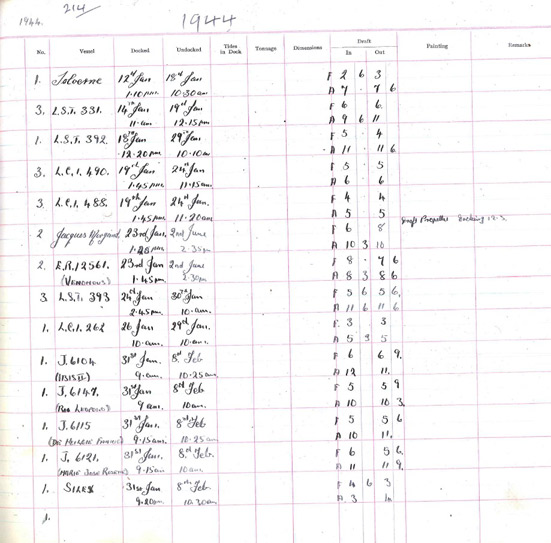 The Silley Cox Log records the dates on which ships enter and leave the four graving (dry) docks HMS Venomous is designated as ER.12561 and enters dry dock 2 at 1.45 pm on 23 January 1944 click twice on linked image to see full size Courtesy of Penny Phillips |
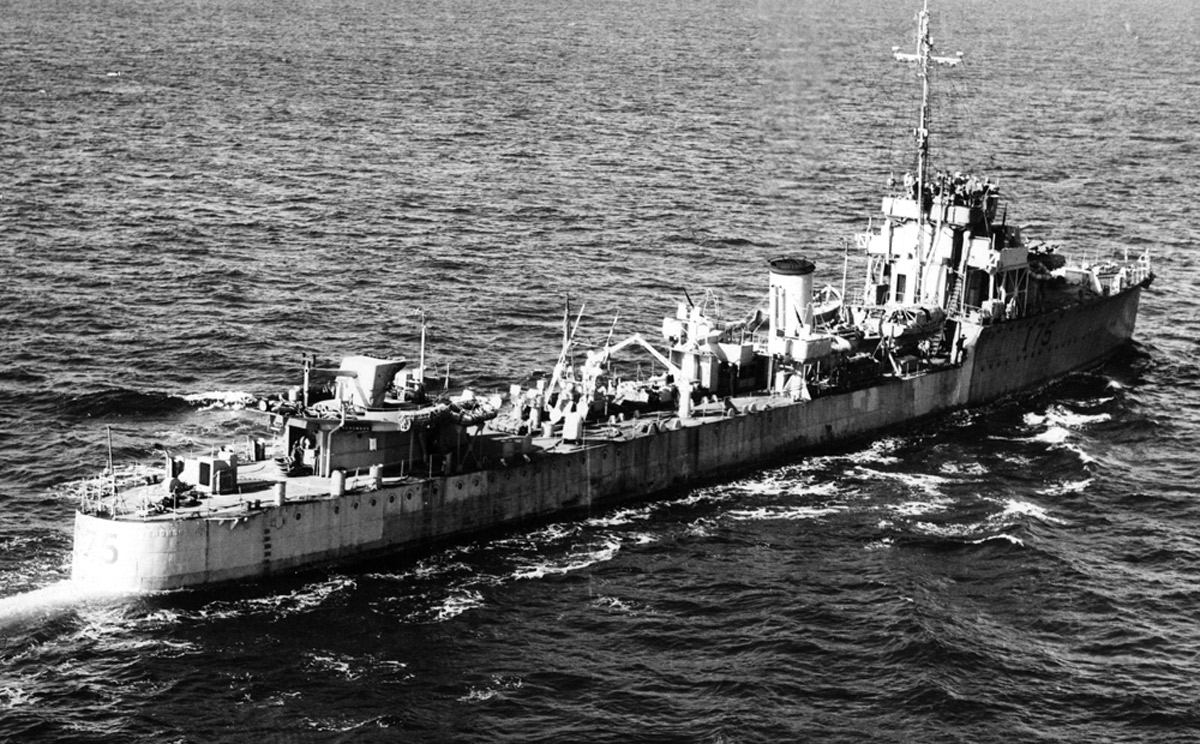
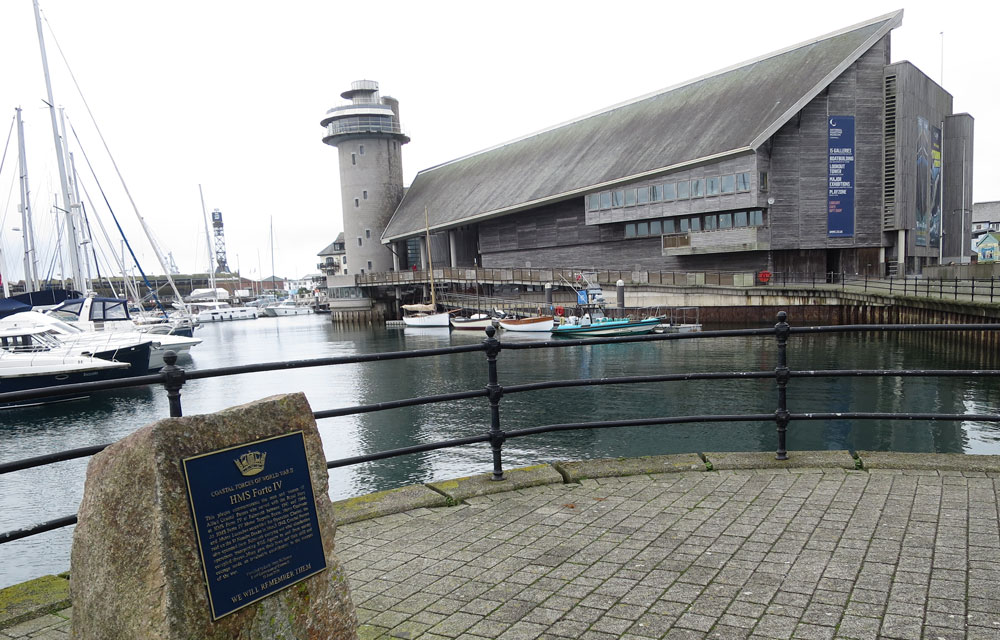
The Bartlett
Maritime Research Centre and Library in the National Maritime Museum
Cornwall is accessible by reseachers without charge
Contact the Hon. Head of Research,Tony Pawlyn, in advance of your visit to describe your area of interest.
The marker in the foreground of the photograph is about the Coastal Forcces base on the Penrhyn River
Photographed by Bill Forster in September 2019
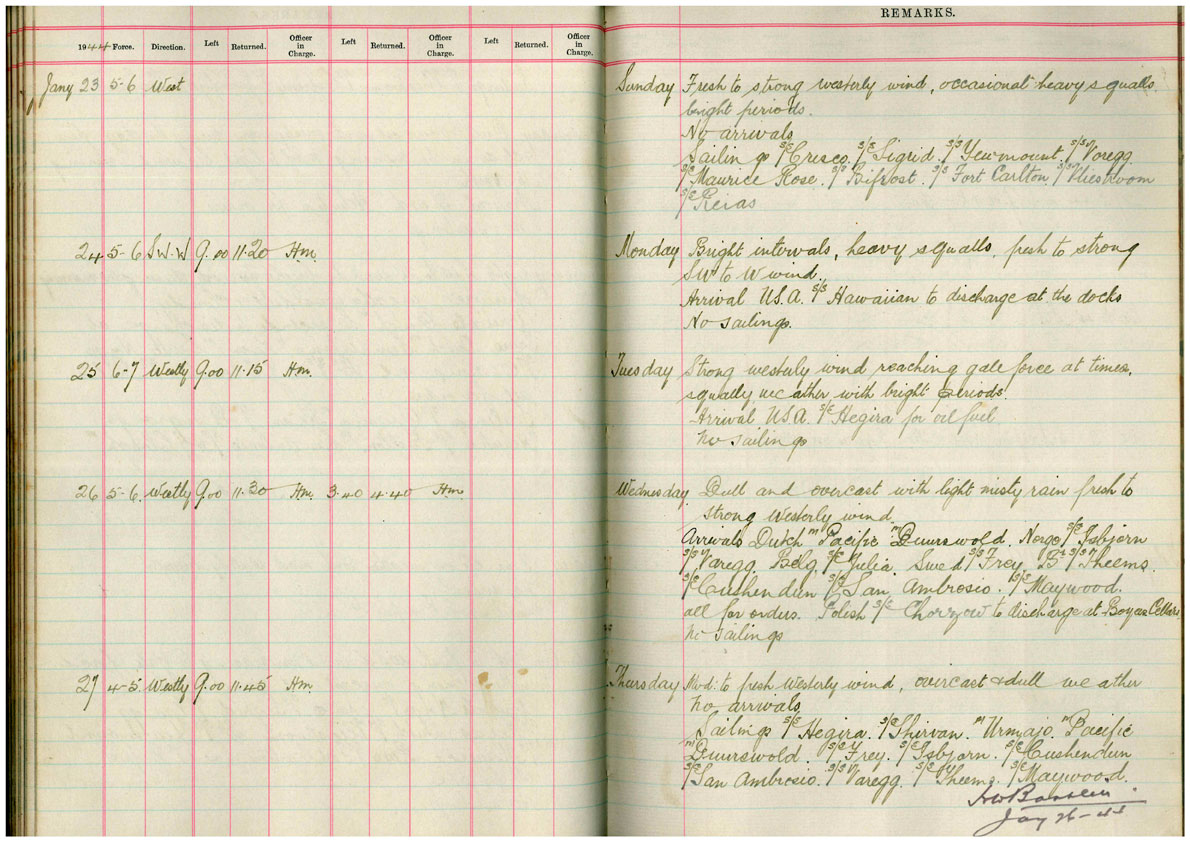
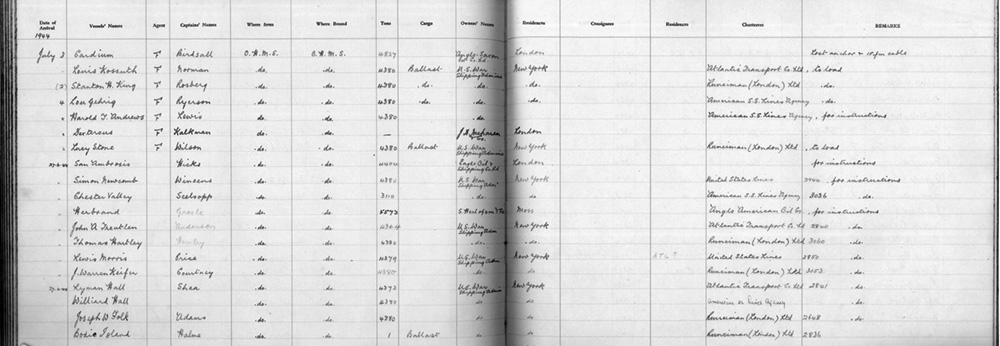

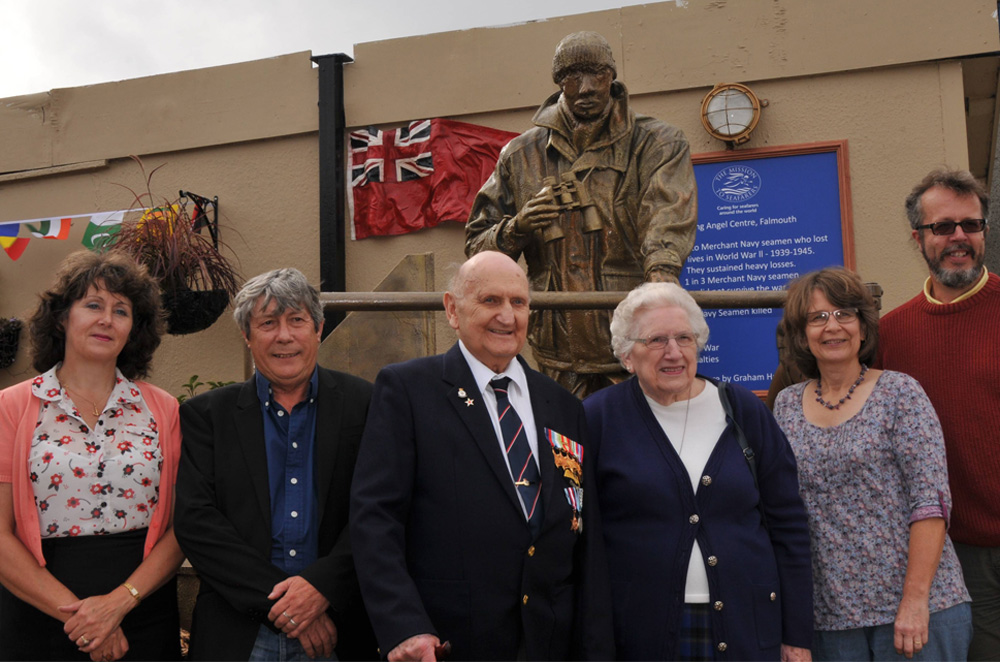
U-Boat Watch, a sculpture by Gaham Hall
Penny Phillips BEM and Graham Hall with Rex Little, an Arctic Convoy veteran and family, at the unveiling in 2014 of Graham's
sculpture outside the Mission to Seafarers in Falmouth Docks
Rex Liitle served in the aircraft carrier HMS Formidable which escorted RA.54A and was 98 when he died at his home near Constantine just outside Falmouth on 12 January 2019
Courtesy of Penny Phillips
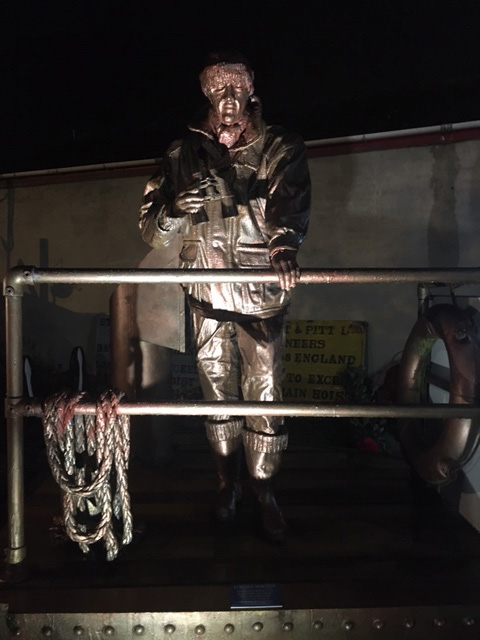 Garham Hall's sculpure is made from glass fibre and resin laid on a wire mesh form His face was first moulded in clay and he stands on steel decking salvaged from a ship |
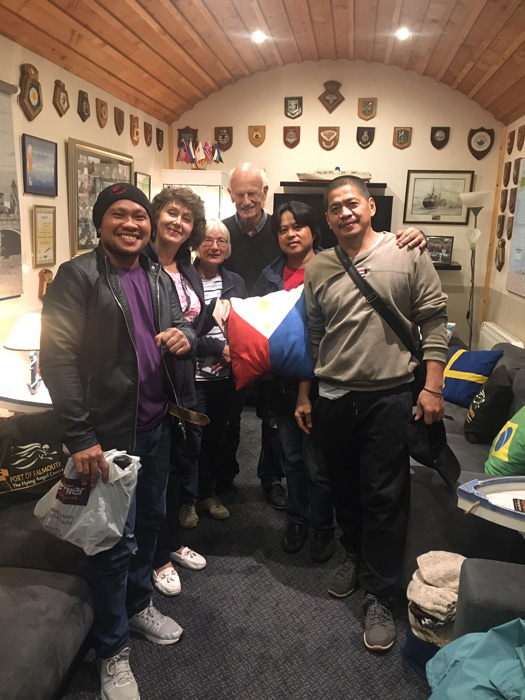 Penny Phillips, Bill Forster and his wife Reinhild in the Flying Angel Centre
With three Phillipino seamen - the colours of the cushion are those of the Phillipines |
